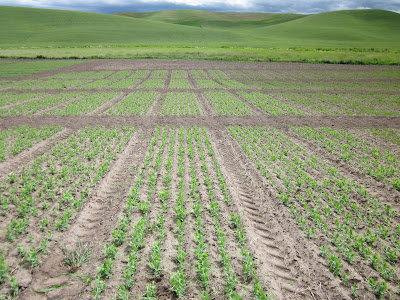So I hope you're sitting down as there is lot's to look at in this episode. This past week I spent several days in Washington, the state out west, not the other one. Anyway, we have some contract research plots out there, so it was time for me to pay a visit. It is in a thriving agricultural area called the Palouse. This is an area of fertile hills and valleys that originated as grasslands, but now have substantial areas of wheat and legumes. The Palouse is generally in Eastern Washington, NE Oregon and West Central Idaho. It's very pretty. While much of the country was baking last week, on Monday it was only in the 50's with light drizzle throughout the day. Below is one of our spring wheat plots evaluating different phosphorus and nitrogen programs at planting. Couldn't really see any differences at this point, but they are well laid out and should give good information come harvest.
Here is another wheat plot in another location, this one evaluating different N and S applications. You can see some of the hills that are a characteristic of the Palouse. There were some farmer's fields that were on incredibly steep hills. We marveled at how you would plant, much less harvest on such steepness. I guess you do it at night so that you can't see where you really are.
Here is a test plot of peas, another important crop in the Palouse. Again see the hills in the background.
And right next to that is a fertilizer test on......lentils! This is the first plot work that I am aware of for Liquid on lentils. Made me long for some soup!
After that we made our way towards Pasco, WA, taking the scenic route. Here is an overlook of Lewiston, ID on the left and Clarkston, WA on the right. Guess who they were named after? There are two rivers flowing together to make an important new river. The Clearwater River on the left is flowing to the West to meet the Snake River flowing to the North, to become the Columbia River. You can kind of see that here.
That night we stayed in Pasco, and ate dinner down by the Columbia River in Kennewick. Below is the bridge between these two of the Tri-Cities. It was very pretty at sunset.
The next day we went up the river to Sunnyside where we have an apple experiment. I did see a number of orchards using this trellis design where the limbs are trained along wire on posts and not have any limbs growing out into the middle. It enables better traffic through the trees, and makes maximum utilization of sunlight. It is similar to the new orchard at the NCRS, although the NCRS orchard has closer planting and this one did not have the fixed spray lines through the canopy along the wire. But it did make a nice set-up for treatments.
Below my traveling companions Sales Account Manager Paulino and ACLF Agronomist Alan take a closer look.
Right next to the apples was a hop yard, which is what you call a place where hops are grown. The Columbia Valley supplies 75% of the hops used by the nation's brewers. See how they grow up the string. This was the first year for these hops, which are perennials and regrow each year. We have had some fertilzer used by hops growers, but have never done plots. Hope to do that next year.
After the apples and hops, Alan headed home to Idaho while Paulino drove me back to Spokane so that I could fly back to Michigan the next day. I like Spokane. These falls on the Spokane River made a nice view for dinner. OK, I don't always have dinner by such great views like tonight and last night. But it's kind of hard to avoid in Washington.
Can't wait till my next trip out there.









